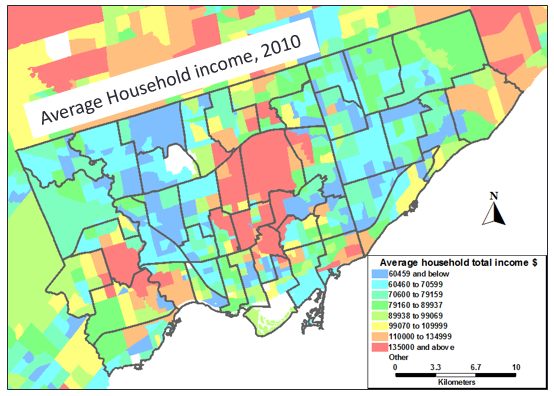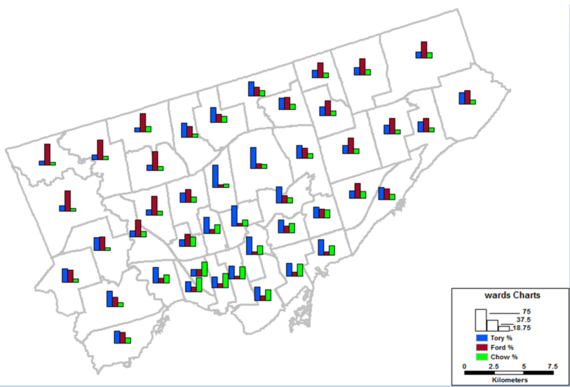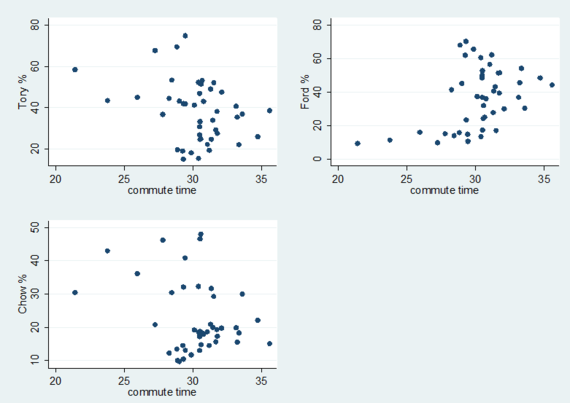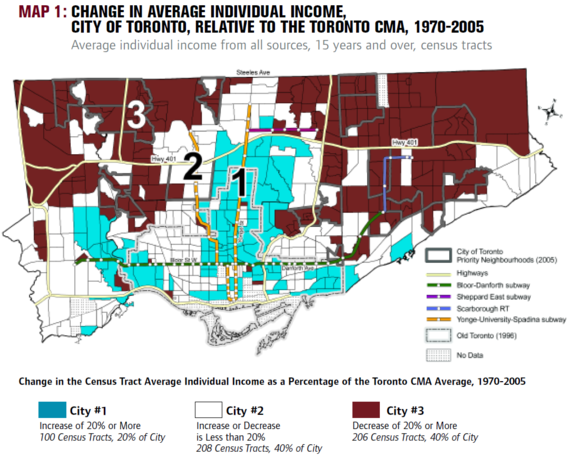
It's a tale of two cities: Toronto the rich, and Toronto the poor. The city's rich have elected a mayor, John Tory, who has won with a convincing margin over his rivals. However, Mr. Tory's support is concentrated in the high-income, central parts of the city. He failed to attract voters in the economically deprived neighbourhoods in the suburbs where the transport and other socio-economic challenges prevail.
In comparison, the runner-up, Doug Ford, has out-polled his rivals in the high-immigrant, low-income, and transit-deprived parts of Scarborough and Etobicoke. In fact, if Toronto were not amalgamated, Mr. Ford would have been the mayor of Scarborough and Etobicoke.
The income polarization in Toronto is now reflected in the political choices of its residents. Mr. Tory captured the imagination and votes of the Toronto's Haves, but not of the City's Have-Nots, who have been pushed to the physical and economic boundaries of the city.
Vote share for Mr. Tory by each ward

Data Source: City of Toronto. Map drawn by (c) Murtaza Haider, 2014.
Income distribution in Toronto (2010)

Data Source: Statistics Canada and the City of Toronto. Map drawn by (c) Murtaza Haider, 2014.
Mr. Tory polled 394,775 votes capturing 40 per cent of the total votes. His two main rivals, Doug Ford and Olivia Chow, received 57 per cent of the votes. Stated differently, more voted for his rivals than they did for Mr. Tory. This comparison is not to diminish his victory. It is to point out that of the 44 wards comprising the City of Toronto, Mr. Tory secured the majority votes (50 per cent or more) in only nine wards. Mr. Ford did better by obtaining the majority votes in 12 wards.
Vote share for the three leading candidates by wards

Data Source: City of Toronto. Map drawn by (c) Murtaza Haider, 2014.
The polarization poses yet another dimension of the spatial mismatch problem. The parts of the city that needed help with public transit and employment opportunities for the immigrants have not voted for Mr. Tory. In fact, a plot of commute times against the respective vote shares for the three leading candidates shows that Mr. Tory's vote share declines with an increase in commute times. At the same time, Mr. Ford's vote share grows with an increase in commute times. This is a reflection of Mr. Ford's support base in parts of Scarborough and Etobicoke that have remained underserved by public transit.
Despite the fact that the administrative boundaries for these municipalities vanished with amalgamation, the deep-rooted political psyches, nurtured by the years of perceived and actual municipal neglect, have survived.
Vote shares for candidates plotted against commute times

Data Source: Statistics Canada and the City of Toronto. Graph drawn by (c) Murtaza Haider, 2014.
Another key lesson to learn from this election is that not all immigrants are created equal. Toronto may be a City of immigrants. However, they voted along the economic and suburban lines. Those who have "made it" voted for Mr. Tory, and those who did not, voted for Olivia Chow and Mr. Ford. Mr. Tory's vote share declines with an increase in the immigrant population. The reverse is true for Mr. Ford whose support increases with the immigrant concentration.
Vote shares for candidates plotted against immigrant concentration

Data Source: Statistics Canada and the City of Toronto. Graph drawn by (c) Murtaza Haider, 2014.
Professor David Hulchanski of the University of Toronto has warned the City about the growing income polarization. He called it the Three Cities comprising the Haves, the Will Haves, and the Have-Nots. The Haves in Toronto are the residents of the neighbourhoods (wards) that experienced significant increase in their incomes since 1970. The Haves live in the central parts of the City and along the Yonge-University subway line. They have overwhelmingly voted for Mr. Tory.
The Will Haves live in the neighbourhoods that have not experienced any relative income growth since 1970, but are hopeful for a better future. They have voted mostly for Mr. Tory and sparingly for Ms. Chow. The Have-Nots are those who live in the neighbourhoods where the incomes, since 1970, have fallen relative to the regional income levels. They have voted overwhelmingly for Mr. Ford.
Toronto: A City Divided

Income polarization and inequality, and not just public transit, should have been the focus of the mayoral campaign. Instead, the media and the candidates made public transit the key issue. The mayoral hopefuls tried their best to outdo the others in promising the biggest, the fastest, and the smartest transit solutions.
The election results should serve a wake-up call to the city elders and the politicians. Toronto is a divided city where income polarization is now manifesting in political outcomes and choices. The Haves have a Mayor and his name is John Tory. The Have-Nots are without a mayor.
It will take some effort on Mr. Tory's part to earn the trust and support of the city's marginalized. He will have to invest time and energy in Scarborough and Etobicoke to improve the lives of those left at the city's (and prosperity's) margins. Given his skills, dedication, and commitment, Mr. Tory should be able to win over those who did not choose him.
Voter turnout and vote share for Mr. Ford and Mr. Tory

The voter turnout offers some insights for Mr. Tory. Mr. Ford has done well in those wards where the voter turnout has been low. This suggests an opportunity. The lower turnout is indicative of the electorate's disengagement. As Mayor of the City of Toronto, Mr. Tory should engage not just his base, but also the rest of the city that lies at the margins. Real development, real dialogue, and real actions will mobilize those who saw no value in the political process.
When the disenfranchised groups observe positive change, they will mobilize and become part of the solution. They will also form the expanded base for the mayor if he is committed to an equitable and just Toronto.